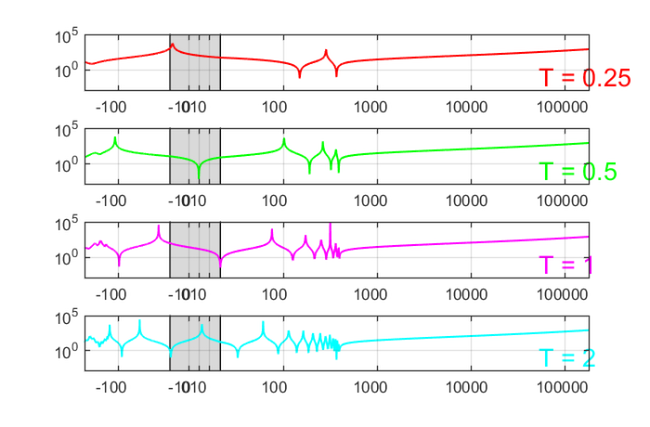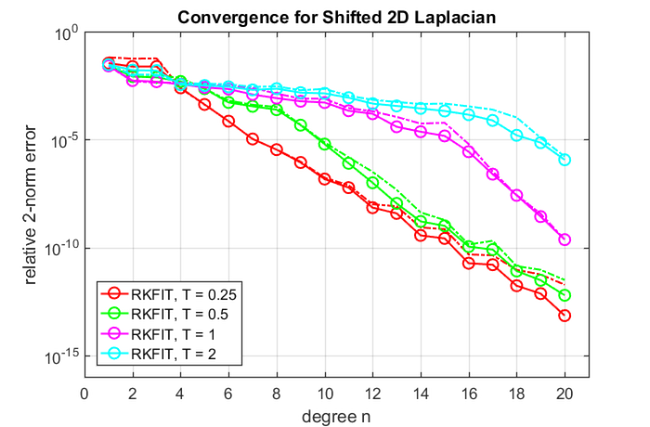Compressing exterior Helmholtz problems: 3D layered waveguide
Stefan GüttelDownload PDF or m-file
Contents
Introduction
This script reproduces Example 7.1 in [1]. It computes RKFIT approximants for  , where
, where  is an indefinite matrix corresponding to the discretization of a 2D Laplacian on a square domain with Neumann boundary conditions; hence DCT2 can be used to diagonalize this matrix. The function
is an indefinite matrix corresponding to the discretization of a 2D Laplacian on a square domain with Neumann boundary conditions; hence DCT2 can be used to diagonalize this matrix. The function  to be approximated is a rather complicated DtN function due to the variability of the coefficient.
to be approximated is a rather complicated DtN function due to the variability of the coefficient.
The code
n = 150; N = n^2; h = 1/n; % grid step (now including boundary points for Neumann bcs) k = 15; L = gallery('tridiag',n); L(1,1) = 1; L(n,n) = 1; L2 = kron(speye(n),L) + kron(L,speye(n)); eeL = 2-2*cos(pi*(0:n-1)/n).'; % evs of L [ee1,ee2] = meshgrid(eeL); eeL2 = (ee1(:)+ee2(:)); % evs of L2 ordered for DCT % fL2v computes f(L2)*v using 2d DCT fL2v = @(f,v) reshape(idct2(reshape(f(eeL2) .* ... reshape(dct2(reshape(v,n,n)),N,1),n,n)),N,1); fL2V = @(f,V) util_colfun(@(v) fL2v(f,v),V); % matrix A and matrix-vector product AV A = 1/h^2*L2 - k^2*speye(N); AV = @(V) fL2V(@(z) z/h^2-k^2,V); % handles for rkfit AB.solve = @(nu, mu, x) fL2v(@(z) 1./(nu*(z/h^2-k^2)-mu),x); AB.multiply = @(rho, eta, x) fL2v(@(z) rho*(z/h^2-k^2)-eta,x); % multipy with f(A) fAV = @(f,V) fL2V(@(z) f(z/h^2-k^2),V); % eigenvalues and spectral interval bounds ee = sort(eeL2/h^2 - k^2).'; %ee = sort(eig(full(A))).'; a1 = min(ee); b1 = max(ee(ee<0)); a2 = min(ee(ee>0)); b2 = max(ee); bt = randn(N,1); bt = bt/norm(bt); % training vector b = randn(N,1); b = b/norm(b); % testing vector % Initialize RKFIT parameters param = struct; param.reduction = 0; param.k = 1; % superdiagonal param.tol = 0; param.real = 0; Thick = [ 0.25, 0.5 , 1 , 2 ]; Colors = { 'r','g','m','c' }; set(0,'RecursionLimit',700);
for j = 1:length(Thick), % loop over different layer thicknesses % Here is the definition of the variable coefficient function c. % Positive values of c "make A more definite" (e.g., if set to c=+k^2, % there is no shift in A at all). You can easily modify c(x). thick = Thick(j); v = [ 0 , 0 , 125*ones(1,round(thick/h)) , -400*ones(1,round(thick/h)) ]; ex = util_dtnfun(h,v); % plot DtN function f_h figure(1), subplot(4,1,j) semilogy(NaN), hold on lint = util_log2lin([b1,a2],[a1,b1,a2,b2],.1); fill([lint(1:2),lint([2,1])], [1e-25,1e-25,1e15,1e15], ... .85*[1,1,1], 'LineStyle', '-') ylim([1e-3,1e5]), ax = [ -10.^(5:-1:1) , 0 , 10.^(1:5) ]; linax = util_log2lin(ax,[a1,b1,a2,b2],.1); set(gca,'XTick',linax,'XTickLabel',ax) xlim([0,1]), grid on, set(gca,'layer','top') xx = sort([ -logspace(log10(-a1),log10(-b1),1000) , linspace(b1,a2,200) , ... logspace(log10(a2),log10(b2),1000) ]); xxt = util_log2lin(xx.',[a1,b1,a2,b2],.1).'; semilogy(xxt,abs(ex(xx)),'r-','Color',Colors{j}); hdl = text(.90,.1,['T = ' num2str(thick) ] ); set(hdl,'FontSize',20,'Color',Colors{j}) % define multiplication with DtN map %FV = @(V) fAV(ex,V); % very slow! fex = ex(eeL2/h^2 - k^2); fex2 = @(x) fex; FV = @(V) fAV(fex2,V); % faster! for m = 1:20, % loop over approximation degrees % run rkfit param.maxit = 10; xi = inf(1,m-1); % m-1 initial poles at infinity [xi,ratfun,misfit,out] = rkfit(FV,AB,bt,xi,param); if m==1, err_rkfitt = out.misfit_initial; iter_rkfit = 0; else [err_rkfitt(m),iter_rkfit(m)] = min(misfit); iter_rkfit(m) = find(misfit <= 1.01*min(misfit),1); end % recompute best ratfun and compute error for vector b param.maxit = iter_rkfit(m); xi = inf(1,m-1); % take m-1 initial poles at infinity [xi,ratfun,misfit,out] = rkfit(FV,AB,bt,xi,param); err_rkfit(m) = norm(FV(b) - fAV(ratfun,b))/norm(FV(b)); end % for m figure(2), hd(j) = semilogy(err_rkfitt,'r-o','Color',Colors{j}); hold on, semilogy(err_rkfit,'r-.','Color',Colors{j}) if 0, % plot iteration numbers labels = num2str(iter_rkfit(:),'%d'); hdl = text((1:m)-.4, err_rkfitt/10, labels, 'horizontal', ... 'left', 'vertical', 'bottom'); set(hdl,'FontSize',13,'Color',Colors{j}) end end % j figure(2) xlim([0,m+1]), ylim([1e-16,1]) xlabel('degree n'), ylabel('relative 2-norm error') legend(hd, 'RKFIT, T = 0.25', 'RKFIT, T = 0.5', 'RKFIT, T = 1', ... 'RKFIT, T = 2', 'Location', 'SouthWest') grid on, title('Convergence for Shifted 2D Laplacian')


Conclusions
Given the many singularities of the DtN function  in the spectral interval of
in the spectral interval of  , we observe a remarkably robust RKFIT convergence. As the layer thickness
, we observe a remarkably robust RKFIT convergence. As the layer thickness  increases, the approximation accuracy deteriorates as expected, but even in the most extreme case RKFIT converges reliably. It is easy to modify this code to other operators
increases, the approximation accuracy deteriorates as expected, but even in the most extreme case RKFIT converges reliably. It is easy to modify this code to other operators  , or other coefficient functions
, or other coefficient functions  .
.
Other examples
The other examples in [1] can be reproduced with the following scripts:
Figure 1.2 - an infinite waveguide with two layers
Example 6.1 - constant coefficient and 1D indefinite Laplacian
Example 6.2 - constant coefficient and 2D indefinite Laplacian
Example 6.3 - uniform approximation on indefinite interval
References
[1] V. Druskin, S. Güttel, and L. Knizhnerman. Compressing variable-coefficient exterior Helmholtz problems via RKFIT, MIMS EPrint 2016.53 (http://eprints.ma.man.ac.uk/2511/), Manchester Institute for Mathematical Sciences, The University of Manchester, UK, 2016.